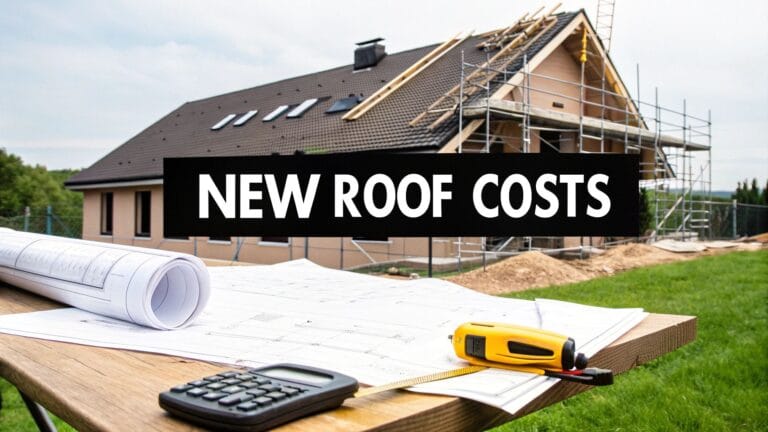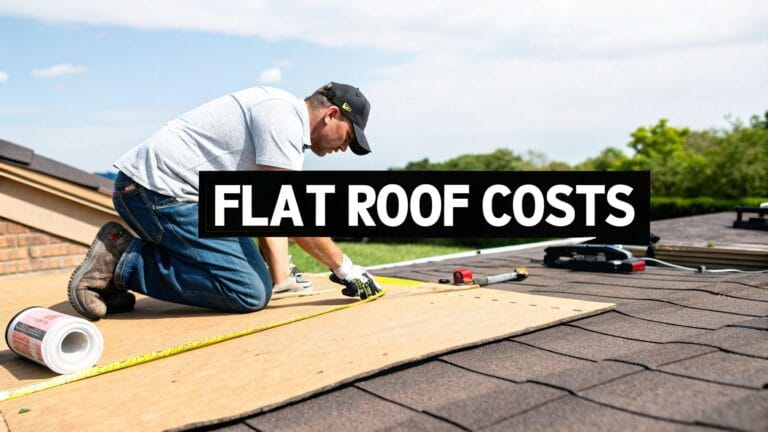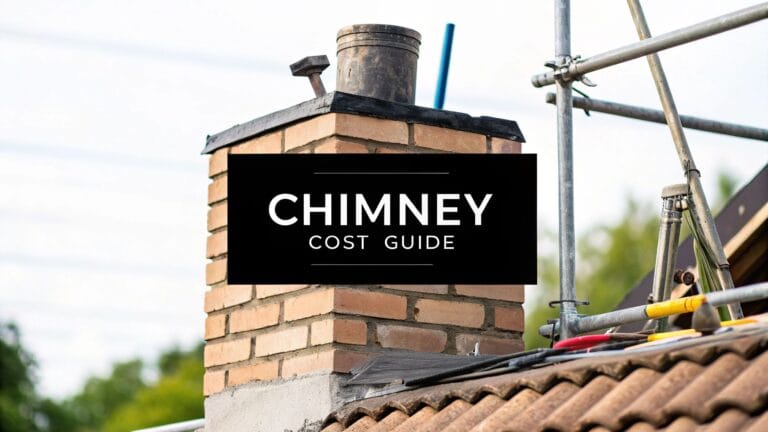
Average Price New Roof UK 2024: A Practical Guide
Discover the average price new roof costs in the UK for 2024. Learn about materials, labour, and hidden expenses to plan your budget confidently.
Trying to pin down the average price for a new roof in the UK can feel like guesswork. The final cost depends entirely on your specific property. It's a lot like buying a car; the final figure on the invoice depends on the make, the model, and all the extras you choose. In the UK, this could mean anything from a few thousand pounds for a simple garage roof up to tens of thousands for a sprawling, intricate slate roof on a large home.
What Is the Average Price for a New Roof?
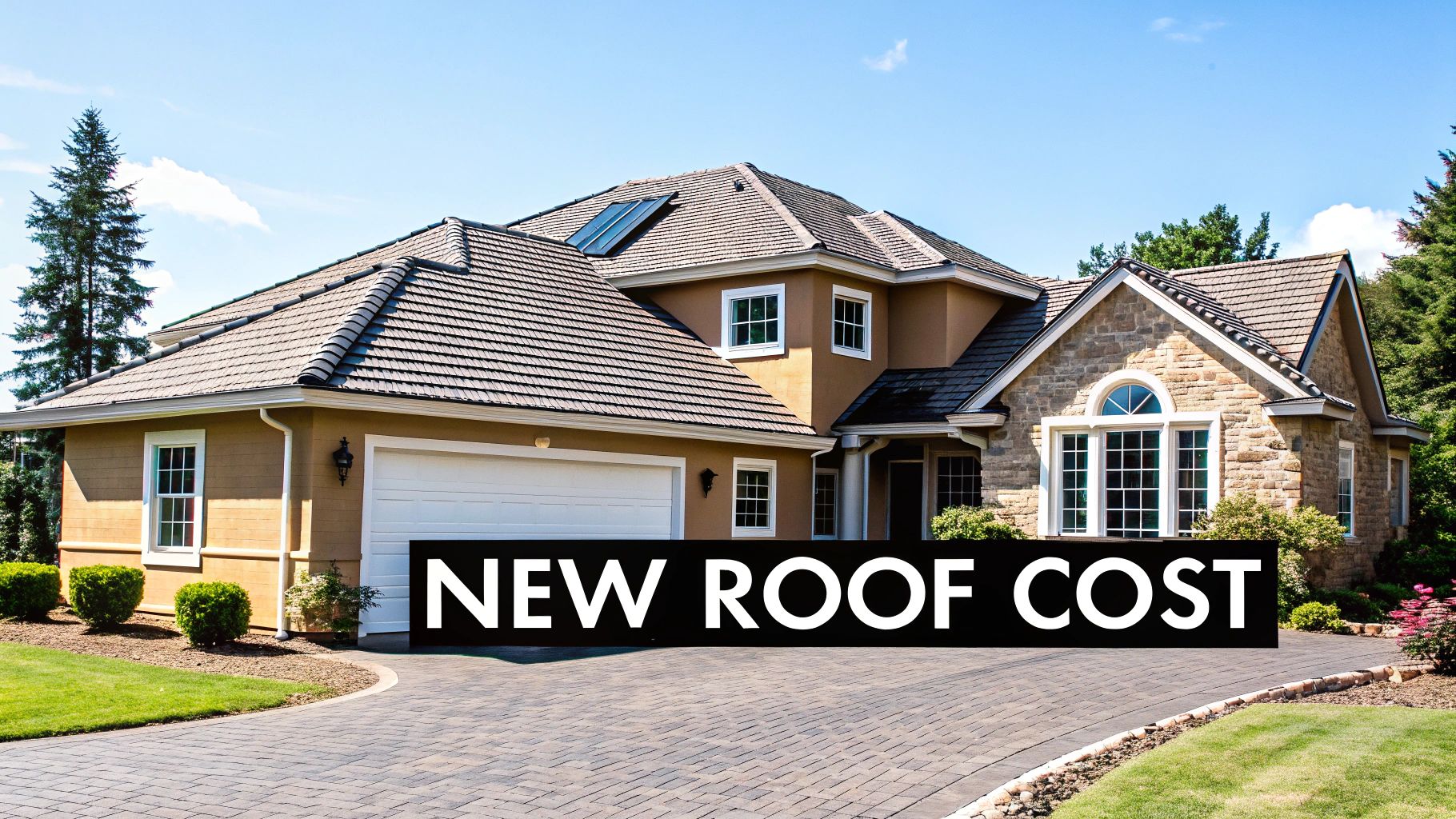
When you first start looking at the numbers for a new roof, it can feel a little daunting. But there’s a logic to it all. The final cost is really just a combination of three key things: the materials you pick, the labour involved, and the specific details of your property. Once you understand these core elements, you can see exactly where your money is going and make the best decision for your home.
On the whole, the average cost for a new roof installation in the UK hovers around £7,000. Most homeowners will find their project falls somewhere between £4,000 and £19,000. Of course, this is a wide range, and the final price depends on the roof's size, your chosen material, and how easy it is for us to access the site.
To give you a better idea, a flat roof replacement usually lands between £2,800 and £7,500. A standard pitched roof with tiles will typically be in the £4,000 to £12,000 bracket. If you're after a premium, long-lasting finish, a slate roof is the top choice, and that will set you back somewhere between £10,000 and £19,000.
A Quick Guide to Average New Roof Costs in the UK
To make these numbers easier to digest, here's a quick at-a-glance table. It breaks down the typical costs and installation times you can expect for the most common roof types.
| Roof Type | Average Price Range | Average Cost per m² | Typical Installation Time |
|---|---|---|---|
| Flat Roof | £2,800 – £7,500 | £40 – £100 | 1 – 3 days |
| Pitched Tiled Roof | £4,000 – £12,000 | £70 – £150 | 4 – 8 days |
| Pitched Slate Roof | £10,000 – £19,000 | £100 – £200 | 6 – 10 days |
This table provides a great starting point, but remember that every project is unique. The complexity of your roof, its size, and any necessary structural repairs can influence the final cost.
Understanding the Price Brackets
Let's break down those price brackets a little more to see what you're getting for your money. Each roof type has a different starting point, and the price per square metre (m²) is what really drives the cost.
- Flat Roofs: Often the most budget-friendly option, perfect for garages, extensions, and outbuildings.
- Tiled Roofs (Concrete or Clay): This is the go-to for most UK homes. They offer a fantastic balance between affordability, durability, and classic good looks.
- Slate Roofs: The premium choice. Slate is famous for its stunning appearance and incredible lifespan—a well-laid slate roof can easily last over a century.
At Evershield Roofing, we believe in total transparency. Our quotes are always fully itemised, so you can see a clear breakdown of costs for materials, labour, scaffolding, and waste disposal. No hidden surprises, no jargon—just an honest price for a top-quality job.
This overview should give you a solid foundation for your budget planning. For an even more detailed look at the factors that shape the final price, you can read our guide on the average cost for a new roof. The main thing to remember is that while averages are helpful, nothing beats a professional assessment from us for an accurate, personalised quote. In the next sections, we’ll explore the specific factors that influence these prices in more detail.
Key Factors That Influence Your Final Roof Price
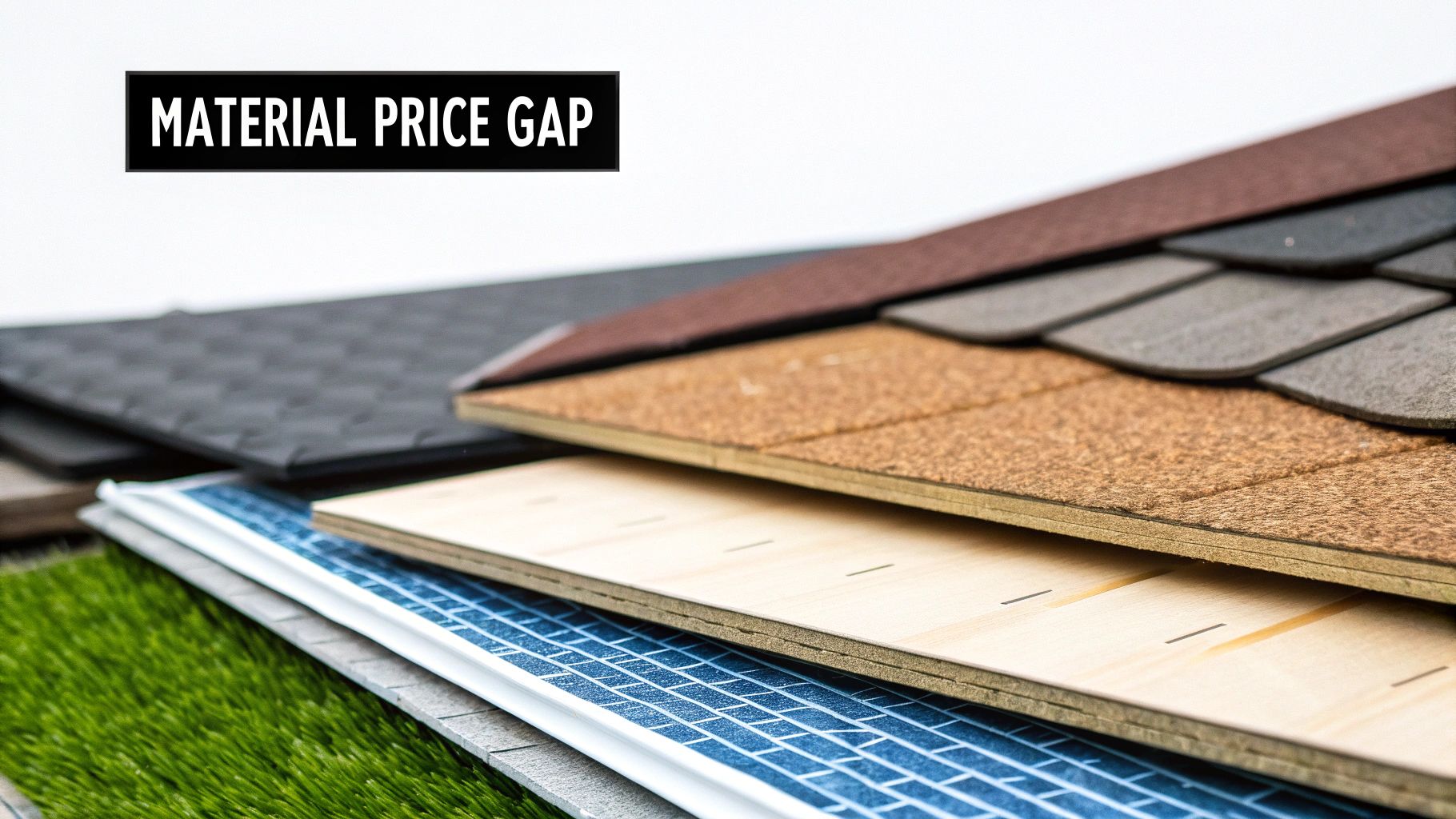
You’ve seen the average price ranges, but you're probably wondering why one new roof costs £5,000 while a similar-looking one down the road is quoted at £15,000. The truth is, the final price comes down to a handful of key variables that go far beyond just the type of tile you choose. Getting to grips with these factors is the best way to understand your quotes and budget properly.
Think of it like this: the roof tiles are the main ingredient, but the size of your roof, the complexity of its design, and the state of the structure underneath all dictate the total effort and cost. A simple, straightforward roof is always going to be less expensive than one with lots of angles and features, even if they use the exact same materials.
These are the elements we, as professional roofers, look for during our initial inspection. Knowing what they are helps you see exactly where your money is going and why the average price new roof can differ so much from one house to the next.
Roof Size and Complexity
This one’s the most obvious starting point. The sheer size of your roof, measured in square metres (m²), is a primary cost driver. It makes sense—a large, detached home will naturally need more materials and more labour from our team than a standard terraced house.
But size is only half the story; complexity is just as important. A simple, rectangular pitched roof is the most straightforward job you can get. The costs really start to climb when we have to work with more complex features that demand specialised skills, extra materials, and a lot more time.
These features include things like:
- Dormer Windows: Those little windows that jut out from the roof slope require incredibly detailed flashing and tile-cutting to create a watertight seal.
- Valleys: Where two different roof slopes meet and form an internal channel, a valley needs to be built perfectly to guide water away.
- Hips: These are the external angles where roof slopes join, and they require special hip tiles and very precise installation.
- Chimney Stacks: Working around a chimney is all about the flashing. If it’s not done right, it’s one of the most common places for a roof to leak.
Every one of these features adds time and technical difficulty to the project, which will be reflected in your final quote. A roof with multiple dormers and valleys is a much more involved job for us than a simple gable-to-gable design.
The Condition of the Underlying Structure
Here’s the biggest unknown. What lies beneath your current roof tiles is a mystery until we strip them off. The timber structure—your rafters, battens, and any sarking or decking—is the skeleton of your roof. If this structure is damaged, it absolutely must be repaired or replaced before we can lay a new covering.
A real-world example: We recently worked on a 1950s semi in Milton Keynes. The owner's budget was based on a standard re-tile. When we stripped the old roof, we found that two of the main timber rafters had severe wood rot from a long-term leak. This required an extra day's work and materials to replace the timbers, adding around £850 to the final bill. We always discuss this possibility upfront, but it shows why a contingency fund is so important.
A good roofer will always look for tell-tale signs during the initial survey, but the full extent of any damage often only becomes clear once the job is underway. This is why our team always discusses contingencies with our clients from the start, so you’re aware of the possibilities.
Access and Additional Logistics
Finally, there are the practicalities of actually getting the work done. These logistical costs are a necessary part of any professional roofing project and cover the essentials for safety and site management.
- Scaffolding: For nearly all re-roofing work in the UK, scaffolding is a non-negotiable safety requirement. The cost will depend on the size and height of your property.
- Waste Removal: Getting rid of tons of old tiles, felt, and battens has to be done properly. This usually means hiring a skip, the cost of which will be included in our quote.
- Ease of Access: If your property is hard to get to—a mid-terrace house with no rear access, for instance—it can complicate things. Moving materials in and waste out takes longer and can add to the labour costs.
By understanding these core components, you’ll be in a much better position to analyse any quote you receive. A detailed quote, like the ones we provide at Evershield Roofing, will always break these elements down for you. To get even more prepared, have a look at our UK new roof cost guide, which gives more detail on what to expect.
Choosing Your Roofing Materials Wisely
The material you pick for your new roof is easily the biggest factor driving the final cost and the overall look of your home. It’s a decision that goes far beyond the initial quote; you're really investing in your property's future, influencing everything from kerb appeal to how much maintenance you’ll be doing down the line.
Think of it like choosing the right coat for winter. A lightweight jacket might be cheaper and fine for a mild day, but a heavy-duty, premium coat will keep you warm for years and stand up to the worst weather. Roofing materials are similar—they offer different levels of protection, longevity, and style, and the best one depends entirely on your home, your budget, and your long-term plans.
To help you get a clear picture of your options, here’s a quick comparison of the most common materials we see on UK homes.
Comparison of Common UK Roofing Materials
| Material | Average Cost per m² (Materials Only) | Estimated Lifespan | Pros | Cons |
|---|---|---|---|---|
| Concrete Tiles | £20 – £45 | 40-50 years | Very cost-effective, durable, wide range of styles and colours. | Heavier than other materials, colour can fade over time. |
| Clay Tiles | £40 – £80 | 60+ years | Classic, timeless look, colour is baked in and won't fade. | More expensive than concrete, can be brittle if walked on incorrectly. |
| Natural Slate | £60 – £120+ | 100+ years | Unmatched premium appearance, incredibly long-lasting, increases property value. | Highest initial cost, requires skilled installation. |
As you can see, the right choice often comes down to balancing that initial cost against how long you want the roof to last and the aesthetic you're aiming for.
Concrete Tiles: A Solid, Budget-Friendly Choice
Concrete tiles are the workhorse of the UK roofing industry, and for good reason. They are incredibly durable, uniform in shape and size, and offer one of the most cost-effective routes to getting a high-quality, long-lasting new roof. If your main focus is getting fantastic value without cutting corners on strength, concrete is the perfect place to start.
What’s more, they come in a huge variety of profiles and colours, often mimicking the appearance of more expensive materials like clay or even slate. This versatility means they fit in well with almost any property style. While the surface colour can fade a bit over many years of British weather, their structural integrity is solid for decades, typically giving you a lifespan of 40-50 years.
Clay Tiles: Classic Aesthetics and Enduring Colour
For homeowners wanting a more traditional and timeless finish, clay tiles are a superb choice. They’re known for their warm, earthy colours—from classic terracotta to deep reds and browns—that are baked right into the tile. Unlike a surface-coated concrete tile, this means the colour doesn't fade; it just weathers beautifully over the years, adding real character to your home.
Clay tiles generally last longer than their concrete counterparts, often protecting your home for over 60 years. They are a step up in price, but that reflects their premium look and exceptional longevity. It’s a fantastic middle-ground investment that blends classic beauty with reliable, long-term performance.
At Evershield Roofing, we always help you weigh these options carefully. We can show you samples of both concrete and clay tiles during our free survey, helping you visualise how each would look on your home and explaining the long-term value each brings.
Natural Slate: The Premium, Lifetime Investment
When it comes to the absolute best in both beauty and durability, nothing beats natural slate. Each tile is a unique piece of quarried stone, which gives your roof a distinctive, high-end appearance that simply cannot be replicated by manufactured materials. The initial average price new roof with slate is the highest, but the benefits are in a class of their own.
A properly installed slate roof can easily last for 100 years or more—often outliving the people who installed it. This incredible longevity means that while the upfront cost is significant, it can actually provide the best value over a lifetime. For listed buildings or homes in conservation areas, slate is often the required choice, but for any homeowner, it represents a true investment in their property’s security and value.
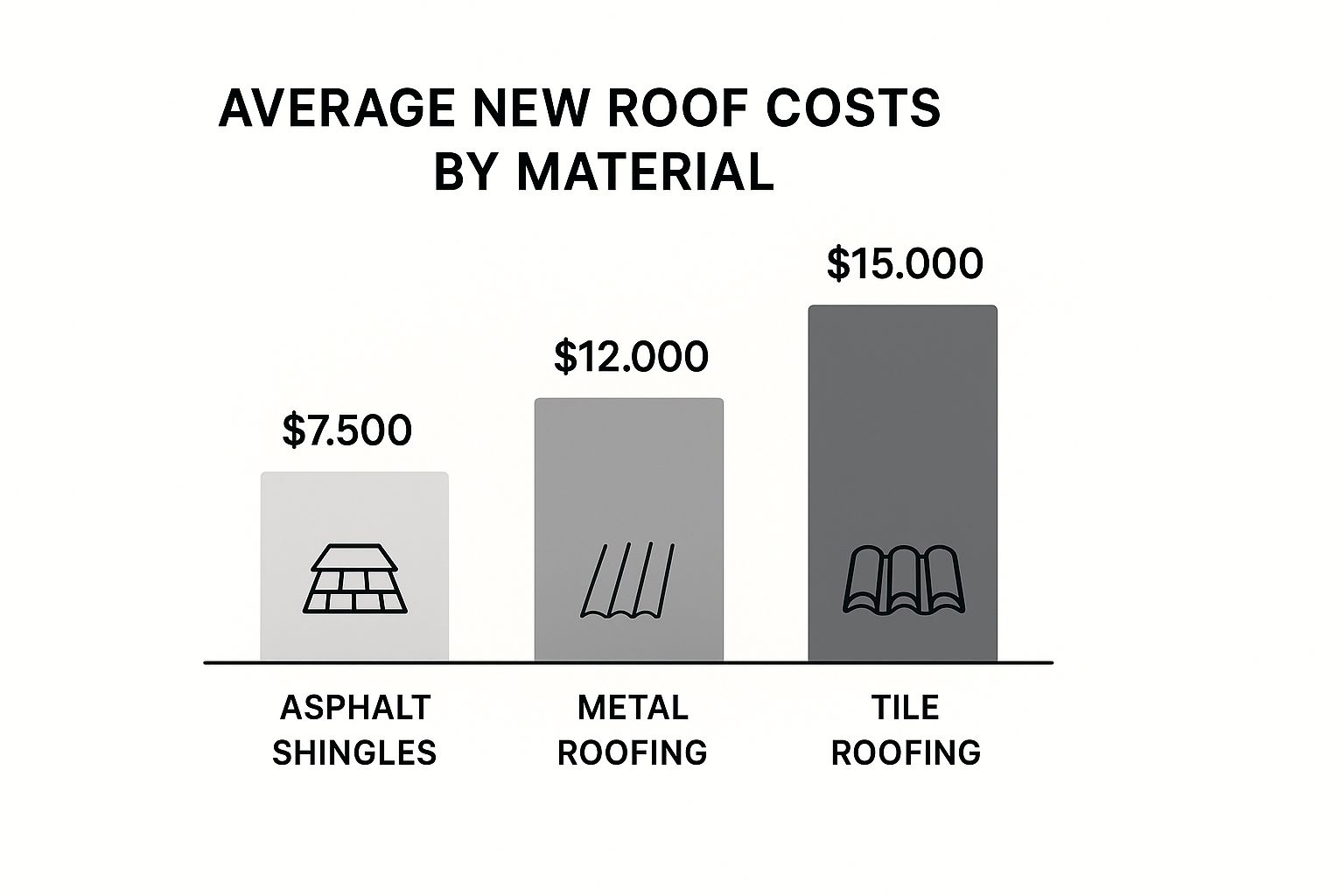
As this infographic shows, your choice of material is what really drives the budget. A more detailed UK cost breakdown shows that material choices heavily influence the final price: concrete tiles typically cost between £120 and £160 per square metre, clay tiles range from £160 to £275 per square metre, and slate tiles fall between £160 and £210 per square metre. Labour adds a significant portion, estimated around £130 per square metre, on top of essentials like scaffolding. You can find more on these roofing costs from Birmingham professionals to get a wider perspective.
Decoding Labour and Other Essential Costs

When you look at a quote for a new roof, it’s easy for your eyes to jump straight to the cost of the tiles or slates. But those materials, as important as they are, are only one piece of the puzzle. A professional roofer's final price is a careful breakdown of several critical costs that go into making sure your new roof is installed safely, legally, and to a standard that will last for years.
Getting your head around these other elements is the key to budgeting properly and avoiding nasty surprises. A huge slice of any quote goes towards the skilled labour needed to do the job right. Think of it this way: you can buy the best ingredients in the world, but you still need a skilled chef to turn them into a Michelin-star meal. It's exactly the same with roofing.
That's why the average price new roof always includes more than just the coverings you can see. It has to account for the expertise, the safety equipment, and the logistics of clearing the site. Without these, you’re not just getting a cheaper job; you’re risking a poor one that will cost you far more down the line.
The Role of Skilled Labour
After the materials themselves, the cost of labour is almost always the next biggest item on the bill. Here in the UK, a good roofer or team will typically work on a day rate. That rate isn't just for someone to bang in a few nails; you're paying for years of experience, a steady hand, and the efficiency that only comes from doing this job day in, day out.
A professional crew like ours works methodically, making sure every single layer of your roof is installed perfectly, from the breathable membrane right up to the final ridge tiles. This skill is what keeps the rain out, protects your home, and gives your roof its lifespan. Opting for a cheaper, less experienced team might look good on paper, but it massively increases the risk of leaks and costly repairs in the future.
Investing in skilled, professional labour is an investment in peace of mind. A properly installed roof by an experienced team like ours at Evershield Roofing is guaranteed to be secure and watertight, protecting your most valuable asset for decades to come.
Essential Add-Ons: Scaffolding and Waste Disposal
There are a couple of line items on a quote that might seem like 'extras', but they are absolutely non-negotiable for any UK re-roofing project. They are about safety and doing the job properly.
Scaffolding: For just about any complete roof replacement in the UK, scaffolding is a legal requirement. It’s there to give us a safe platform to work from and to protect your family, your property, and the public below. The cost will depend on the size and shape of your house, but it’s a non-starter to attempt a major roofing job without it.
Waste Disposal (Skip Hire): Tearing off an old roof creates a staggering amount of waste. We’re often talking several tonnes of old tiles, timber battens, and felt. All that material has to be taken away and disposed of responsibly. Our quotes always include the cost of a skip that’s big enough for the job, so the site stays tidy and the waste is handled correctly.
Honestly, these so-called 'hidden' costs are just the price of doing the job right. Any quote that leaves them out should be a massive red flag. It usually means someone is planning to cut corners on safety and compliance.
Compliance with UK Building Regulations
Finally, you need to be aware of UK Building Regulations. They aren't just red tape; they are there to make sure our homes are safe, structurally sound, and energy-efficient, and they can affect the cost of your project.
For roofing, a major rule kicks in when a large part of the roof is being replaced. The regulations say that if you’re refurbishing more than 50% of the roof, you are legally required to upgrade the thermal insulation to meet today's standards. This is a crucial detail to know, as it can add an extra layer of cost for materials and labour. You can get a better sense of how these regulatory requirements affect roof costs to be fully prepared.
At Evershield Roofing, we take care of all this for you. Our team is fully up-to-date with the latest UK regulations, ensuring your new roof isn't just strong and good-looking, but completely compliant, with no last-minute, unexpected costs.
Our Approach to Accurate Roofing Quotes
Knowing the average cost of a new roof is useful, but it’s just a ballpark figure. Every UK home is different, and a generic price won't account for the unique character and condition of your property. That’s why you need a detailed, transparent quote from a trusted local expert. Here at Evershield Roofing, we specialise in turning those vague estimates into a clear, straightforward plan for your new roof.
We believe a proper quote can't be done over the phone or based on a quick look at a satellite image. A roof is a complex system, and to price it right, you need to get up close and personal. Our entire process is built around that simple, honest fact.
The Initial No-Obligation Consultation
It all starts with a friendly chat. We want to hear what’s on your mind. Are you fed up with persistent leaks? Thinking about boosting your home's kerb appeal? Or maybe you're in the middle of a big renovation project? This first conversation helps us understand your goals before we even set foot on your property.
Next, we'll find a time that works for you to carry out a thorough, hands-on inspection. This is the single most important part of the process. We don’t just count the tiles; we dive deep into the health of your entire roofing system.
Our inspection always covers:
- Structural Integrity: We’ll examine the roof structure from the inside out, looking for any red flags like sagging timbers or water damage.
- Underlying Issues: We look for the subtle clues that hint at bigger problems—things like damp patches in the loft, crumbling mortar, or failing flashing around chimneys and vents.
- Access and Safety: We figure out the practicalities. What kind of scaffolding is needed to work safely and efficiently? How will we get materials up and old debris down with minimal disruption to you and your neighbours?
Our commitment is to total transparency. We find that an informed homeowner is a confident homeowner. By walking you through what we’re seeing during the inspection, we help you understand the real-world factors that go into the final cost.
A Fully Itemised and Transparent Quote
After the survey, we don’t just hand you a single figure on a piece of paper. We provide a fully itemised, written quote that breaks down the entire project. You'll see exactly what everything costs, from the first tile to the last nail.
Understanding how to find a good contractor often comes down to this level of transparency. We make sure our quotes are crystal clear, so you know precisely where your investment is going.
Your Evershield Roofing quote will clearly outline:
- Materials: The specific type and amount of tiles or slates, breathable membrane, battens, and all necessary fixings.
- Labour: The cost for our skilled, local roofing team to complete the job to the highest professional standard.
- Scaffolding: The complete price for the hire, erection, and dismantling of all necessary safety scaffolding.
- Waste Disposal: The cost for a skip and the responsible disposal of all the old roofing materials we remove.
This clarity means no nasty surprises down the line. It also helps you see the true value in using our quality materials and professional labour—the two things that guarantee a weatherproof, long-lasting, and fantastic-looking roof.
For more tips, check out our guide on choosing the right contractor for your new roof, which covers the key questions you should ask anyone you're considering. By being open from the start, we build the trust that makes you feel secure in your decision.
Your Top Roofing Questions Answered
Even with all the numbers and material options laid out, you probably still have a few questions buzzing in your head. That’s completely normal. Getting a new roof is a big deal, and feeling confident about every last detail is the best way to move forward.
Think of this as the final, practical part of our guide, where we tackle the common "what ifs" and "how longs" we hear from UK homeowners every day. We’ll get straight to the point on timelines, planning rules, and making sure you get a fair price.
How Long Does It Take to Replace a Roof?
One of the first things everyone wants to know is, "How long is my house going to be a work site?" The truth is, it depends. The size and shape of your roof, the materials you pick, and—of course—the famously unpredictable British weather all play a part.
For a typical 3-bedroom semi-detached house in the UK, a standard roof replacement with concrete or clay tiles usually takes between 3 to 5 days. That timeframe gets you from the old roof coming off to the new one being fully watertight.
Here’s a rough idea of how the week might unfold with our team:
- Day 1: Scaffolding goes up, and we prep the site for the work ahead.
- Day 2-3: The heavy lifting happens here. We’ll strip off all the old tiles, battens, and felt, then lay the new breathable membrane and timber battens.
- Day 4-5: The new tiles or slates are carefully laid, and all the finishing touches—like the ridge, hip, and verge systems—are installed to seal everything up.
If you have a larger detached home or you’ve chosen a material like natural slate, which takes a bit more time and skill to get right, you could be looking at 7-10 days. On the flip side, a simple flat roof is often a much quicker job, usually wrapped up in just 2-4 days. At Evershield Roofing, we build a realistic project timeline right into our quotes, so you know exactly what to expect before we even start.
Do I Need Planning Permission for a New Roof?
This is a big one, and the news is generally good. For most re-roofing jobs in the UK, you do not need planning permission. It’s usually classed as 'permitted development', which means it's pre-approved as long as you stick to a few rules.
However, there are a few very important exceptions where you absolutely need to check with your local authority first.
You will almost certainly need planning permission if:
- Your house is a listed building.
- You live in a Conservation Area, an Area of Outstanding Natural Beauty, or a National Park.
- The work will dramatically change the height or shape of your roof.
In places like Conservation Areas, the council often has strict rules on what materials you can use to protect the look and feel of the neighbourhood. Trying to swap traditional slates for modern concrete tiles, for instance, would almost certainly be a non-starter. When in doubt, it’s always best to check. We recommend a quick call to your local planning authority if you have any concerns, and we’re always happy to offer our advice during a consultation.
The bottom line is this: a like-for-like replacement rarely needs permission, but any major change to how your roof looks is worth a phone call to the council. It’s a simple step that can save you a world of hassle.
How Can I Be Sure I Am Getting a Fair Price?
Making sure you’re getting a fair deal on the average price new roof really comes down to two things: doing your research and picking a reputable roofer. The single best thing you can do is get at least three detailed, written quotes from different local companies. This lets you compare not just the final number, but the quality of materials and the exact work included.
A proper, trustworthy quote should be itemised, breaking down the costs for:
- Materials (tiles, membrane, battens, etc.)
- Labour
- Scaffolding
- Waste disposal (like skip hire)
Be very cautious of any quote that looks too good to be true. A rock-bottom price often signals that corners are being cut, whether that’s through shoddy materials, unsafe practices, or unskilled workers. Those kinds of shortcuts can lead to a roof that fails years before it should, costing you much more in the long run. Always ask for proof of credentials, like trade association memberships and public liability insurance. Checking references and seeing a portfolio of their recent work in your area is also a very smart move.
What About Solar Panels and My New Roof?
With high energy bills, we’re often asked about installing solar panels at the same time as a new roof. It makes sense on the surface—why not get it all done at once? Some UK solar companies will even offer to roll the cost of a new roof into their financing package, sometimes presenting it as a 'free' bonus.
You need to be careful here. That 'free' roof isn't really free; its cost is simply bundled into your long-term loan for the solar panels. While it seems convenient, you could end up financing your roof over 25 years, paying decades of interest on it.
There’s also the stability of the solar company to think about. We've seen firms go out of business, leaving homeowners with an unsupported solar system and no warranty. Suddenly, the panels become a problem rather than an asset, especially when you try to sell your house. The green benefits are obvious, but the financial side needs very careful consideration.
At Evershield Roofing, we believe our job is to give you honest, straightforward advice so you can make the best choice for your home and your wallet. Our quoting process is built to give you total clarity and peace of mind.
Ready to get a clear, no-obligation quote for your new roof? Contact us today for a free survey and expert advice.

